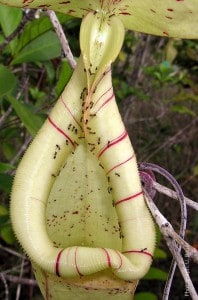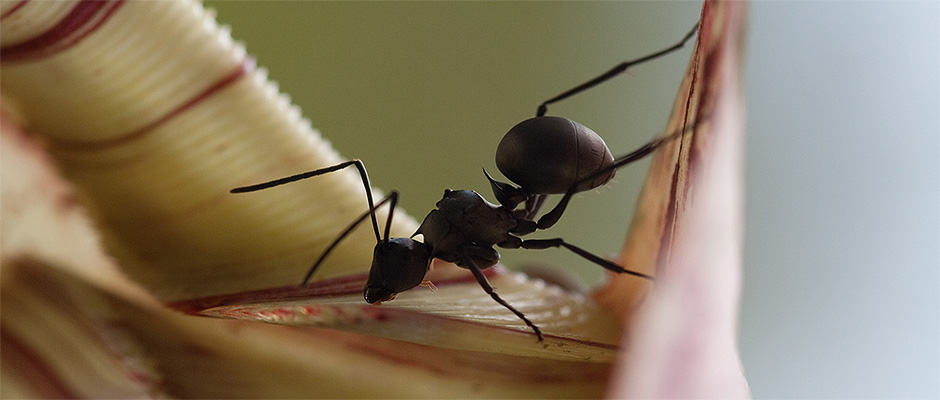Share this article
Crafty Pitcher Plants Prove No Brains Are Better than One
It could be called the art of war — there’s no good reason to kill a simple scout when you can lure an entire army into an ambush.

The trap of an insect-eating Nepenthes pitcher plant, swarming with nectar-collecting ants. Research from the University of Bristol, UK, has found that, by ‘switching off’ its traps for part of the day, the plant ensures ‘scout’ ants survive and are able to lead large numbers of followers to the trap. When the trap gets wet, it suddenly becomes super-slippery and captures all visitors in one sweep.
Image Credit: Dr Ulrike Bauer, University of Bristol, UK
New research shows that carnivorous pitcher plants in Borneo have a mechanism that allows them to switch off the slippery texture of the lips when individual ants are sent out to scout the areas for potential food. “The plant’s key trapping surface is extremely slippery when wet but not when dry,” said Ulrike Bauer from Bristol’s School of Biological Sciences and the lead author of a paper released today in Proceedings of the Royal Society B.
Bauer said the findings were strange because the traps act as if they are “switched off” during dry days for up to eight hours at a time. “At first sight, this is puzzling because natural selection should favor traps that catch as many insects as possible,” Bauer said. But when the researchers manipulated the pitcher plants to keep them wet all day, they found that the pitcher plants caught individual ants, but never larger batches of ants that had been observed in some plants in natural conditions.
The reason could be that the pitcher plants are outsmarting the ants’ intelligence and reconnaissance system.
“Ants are social insects,” he said. “Individual ‘scout’ ants search the surroundings of the nest for profitable food sources. When they find a pitcher trap full of sweet nectar, they go back to the colony and recruit many more ant workers.”
But the traps that were slippery all the time killed the messenger before it had a chance to bring in all its buddies.
“By ‘switching off’ their traps for part of the day, pitcher plants ensure that scout ants can return safely to the colony and recruit nest-mates to the trap,” Bauer said. “Later, when the pitcher becomes wet, these followers get caught in one sweep. What looks like a disadvantage at first sight, turns out to be a clever strategy to exploit the recruitment behavior of social insects.”
Header Image: A worker ant collects sweet nectar from the trap of an insect-eating Nepenthes pitcher plant. Research from the University of Bristol, UK, has found that, by 'switching off' its traps for part of the day, the plant ensures 'scout' ants survive and are able to lead large numbers of followers to the trap. When the trap gets wet, it suddenly becomes super-slippery and captures all visitors in one sweep. Image Credit: Dr. Ulrike Bauer, University of Bristol, UK








